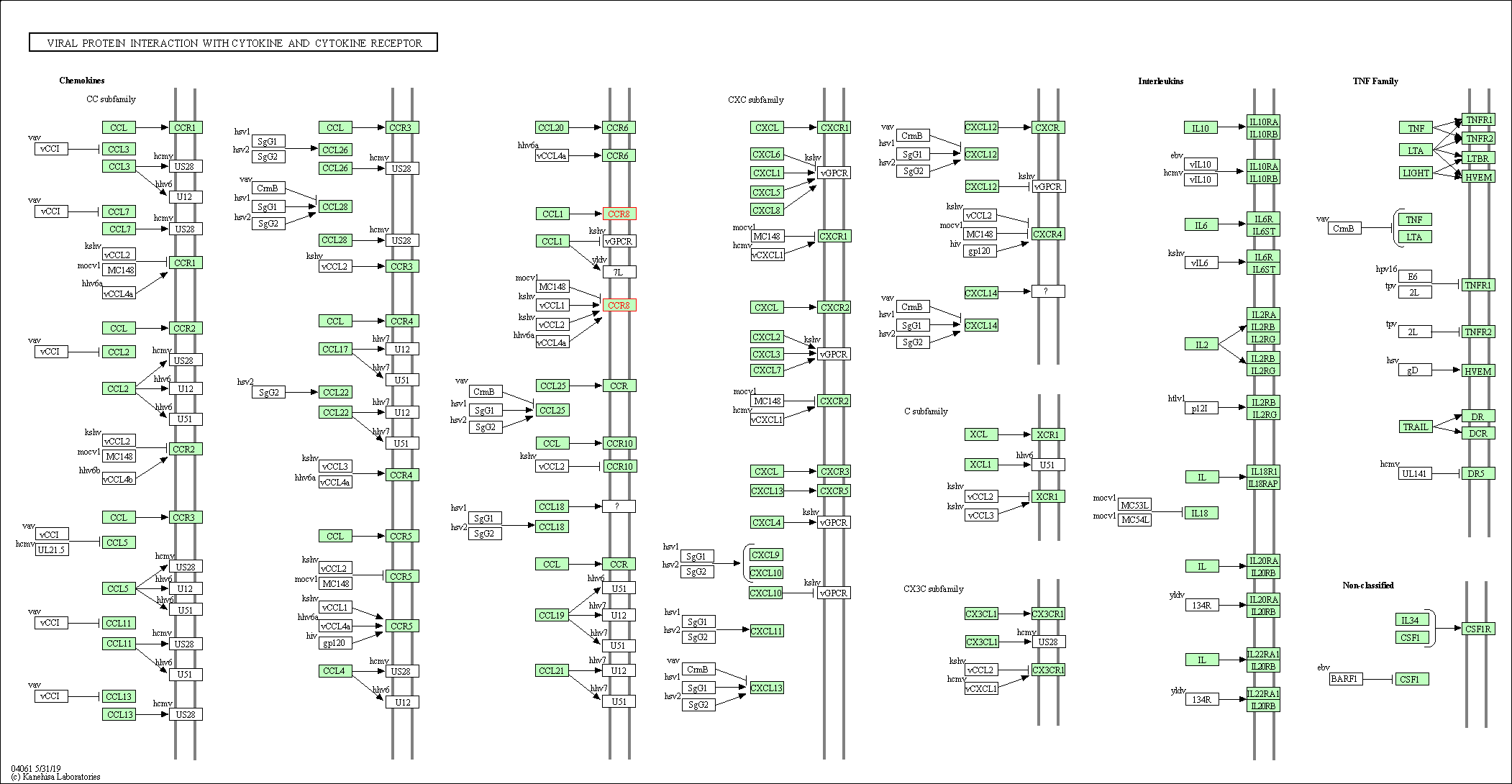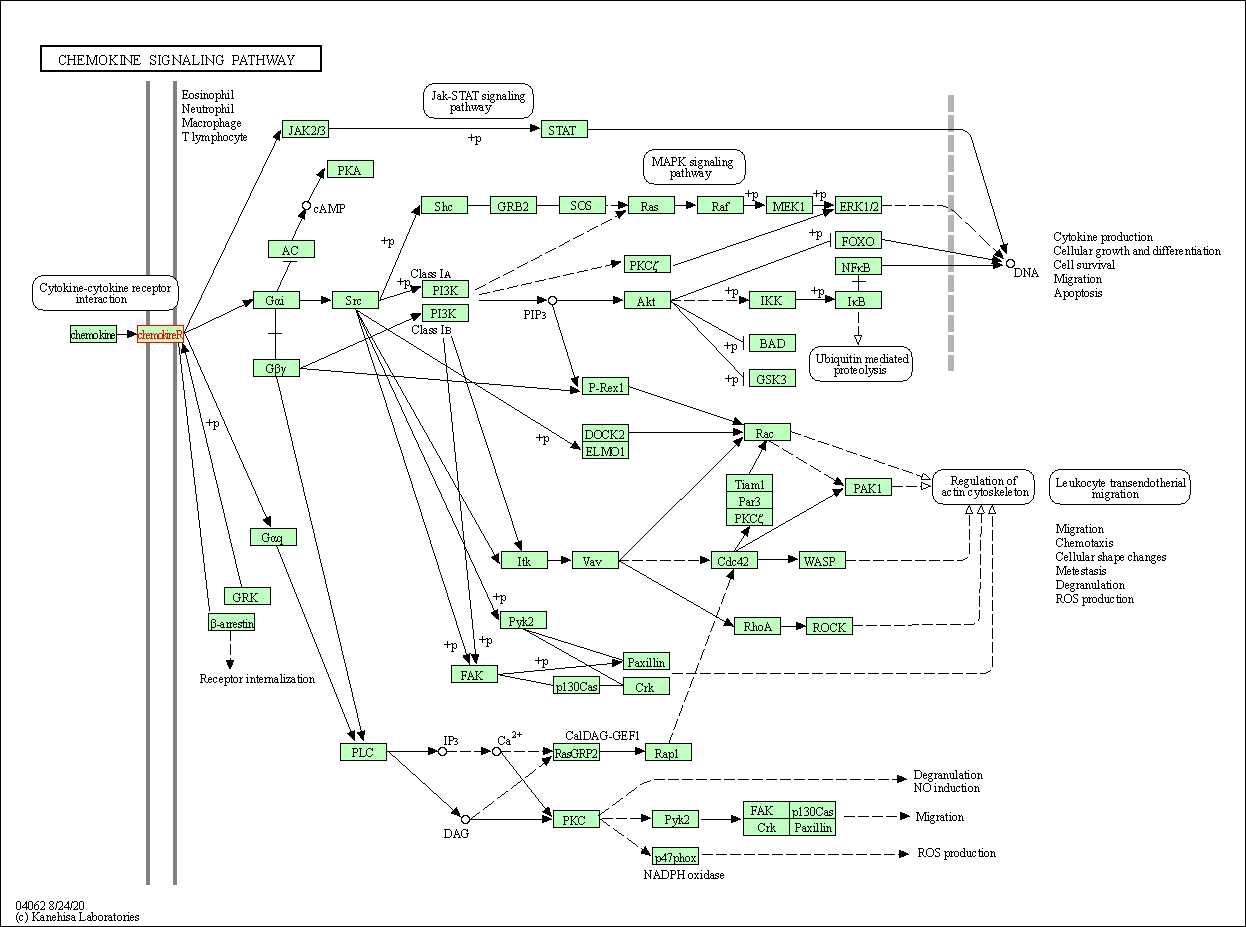Target Information
| Target General Information | Top | |||||
|---|---|---|---|---|---|---|
| Target ID |
T20575
(Former ID: TTDR00763)
|
|||||
| Target Name |
C-C chemokine receptor type 8 (CCR8)
|
|||||
| Synonyms |
TER1; GPRCY6; GPR-CY6; Chemokine receptor-like 1; Chemokine receptor CCR8; CMKBRL2; CMKBR8; CKRL1; CKR-L1; CDw198; CCR-8; CC-chemokine receptor CHEMR1; CC-CKR-8; CC chemokine receptor CHEMR1; C-C CKR-8
Click to Show/Hide
|
|||||
| Gene Name |
CCR8
|
|||||
| Target Type |
Clinical trial target
|
[1] | ||||
| Disease | [+] 1 Target-related Diseases | + | ||||
| 1 | Solid tumour/cancer [ICD-11: 2A00-2F9Z] | |||||
| Function |
May regulate monocyte chemotaxis and thymic cell line apoptosis. Alternative coreceptor with CD4 for HIV-1 infection. Receptor for the chemokine CCL1/SCYA1/I-309.
Click to Show/Hide
|
|||||
| BioChemical Class |
GPCR rhodopsin
|
|||||
| UniProt ID | ||||||
| Sequence |
MDYTLDLSVTTVTDYYYPDIFSSPCDAELIQTNGKLLLAVFYCLLFVFSLLGNSLVILVL
VVCKKLRSITDVYLLNLALSDLLFVFSFPFQTYYLLDQWVFGTVMCKVVSGFYYIGFYSS MFFITLMSVDRYLAVVHAVYALKVRTIRMGTTLCLAVWLTAIMATIPLLVFYQVASEDGV LQCYSFYNQQTLKWKIFTNFKMNILGLLIPFTIFMFCYIKILHQLKRCQNHNKTKAIRLV LIVVIASLLFWVPFNVVLFLTSLHSMHILDGCSISQQLTYATHVTEIISFTHCCVNPVIY AFVGEKFKKHLSEIFQKSCSQIFNYLGRQMPRESCEKSSSCQQHSSRSSSVDYIL Click to Show/Hide
|
|||||
| 3D Structure | Click to Show 3D Structure of This Target | AlphaFold | ||||
| Drugs and Modes of Action | Top | |||||
|---|---|---|---|---|---|---|
| Clinical Trial Drug(s) | [+] 1 Clinical Trial Drugs | + | ||||
| 1 | GS-1811 | Drug Info | Phase 1 | Solid tumour/cancer | [2] | |
| Discontinued Drug(s) | [+] 1 Discontinued Drugs | + | ||||
| 1 | CCX-832 | Drug Info | Discontinued in Phase 1 | Psoriasis vulgaris | [3] | |
| Mode of Action | [+] 4 Modes of Action | + | ||||
| Antagonist | [+] 2 Antagonist drugs | + | ||||
| 1 | CCX-832 | Drug Info | [1] | |||
| 2 | viral macrophage inflammatory protein-II | Drug Info | [7] | |||
| Binder | [+] 1 Binder drugs | + | ||||
| 1 | I-309 | Drug Info | [5] | |||
| Inhibitor | [+] 2 Inhibitor drugs | + | ||||
| 1 | N-(4-phenylsulfamoyl-naphthalen-1-yl)-benzamide | Drug Info | [6] | |||
| 2 | N-{4-[(benzylamino)sulfonyl]-1-naphthyl}benzamide | Drug Info | [6] | |||
| Agonist | [+] 1 Agonist drugs | + | ||||
| 1 | ZK 756326 | Drug Info | [8] | |||
| Cell-based Target Expression Variations | Top | |||||
|---|---|---|---|---|---|---|
| Cell-based Target Expression Variations | ||||||
| Different Human System Profiles of Target | Top |
|---|---|
|
Human Similarity Proteins
of target is determined by comparing the sequence similarity of all human proteins with the target based on BLAST. The similarity proteins for a target are defined as the proteins with E-value < 0.005 and outside the protein families of the target.
A target that has fewer human similarity proteins outside its family is commonly regarded to possess a greater capacity to avoid undesired interactions and thus increase the possibility of finding successful drugs
(Brief Bioinform, 21: 649-662, 2020).
Human Pathway Affiliation
of target is determined by the life-essential pathways provided on KEGG database. The target-affiliated pathways were defined based on the following two criteria (a) the pathways of the studied target should be life-essential for both healthy individuals and patients, and (b) the studied target should occupy an upstream position in the pathways and therefore had the ability to regulate biological function.
Targets involved in a fewer pathways have greater likelihood to be successfully developed, while those associated with more human pathways increase the chance of undesirable interferences with other human processes
(Pharmacol Rev, 58: 259-279, 2006).
Biological Network Descriptors
of target is determined based on a human protein-protein interactions (PPI) network consisting of 9,309 proteins and 52,713 PPIs, which were with a high confidence score of ≥ 0.95 collected from STRING database.
The network properties of targets based on protein-protein interactions (PPIs) have been widely adopted for the assessment of target’s druggability. Proteins with high node degree tend to have a high impact on network function through multiple interactions, while proteins with high betweenness centrality are regarded to be central for communication in interaction networks and regulate the flow of signaling information
(Front Pharmacol, 9, 1245, 2018;
Curr Opin Struct Biol. 44:134-142, 2017).
Human Similarity Proteins
Human Pathway Affiliation
Biological Network Descriptors
|
|
| KEGG Pathway | Pathway ID | Affiliated Target | Pathway Map |
|---|---|---|---|
| Cytokine-cytokine receptor interaction | hsa04060 | Affiliated Target |

|
| Class: Environmental Information Processing => Signaling molecules and interaction | Pathway Hierarchy | ||
| Viral protein interaction with cytokine and cytokine receptor | hsa04061 | Affiliated Target |

|
| Class: Environmental Information Processing => Signaling molecules and interaction | Pathway Hierarchy | ||
| Chemokine signaling pathway | hsa04062 | Affiliated Target |

|
| Class: Organismal Systems => Immune system | Pathway Hierarchy | ||
| Degree | 3 | Degree centrality | 3.22E-04 | Betweenness centrality | 2.03E-04 |
|---|---|---|---|---|---|
| Closeness centrality | 1.40E-01 | Radiality | 1.16E+01 | Clustering coefficient | 0.00E+00 |
| Neighborhood connectivity | 1.67E+00 | Topological coefficient | 3.33E-01 | Eccentricity | 14 |
| Download | Click to Download the Full PPI Network of This Target | ||||
| Chemical Structure based Activity Landscape of Target | Top |
|---|---|
| Drug Property Profile of Target | Top | |
|---|---|---|
| (1) Molecular Weight (mw) based Drug Clustering | (2) Octanol/Water Partition Coefficient (xlogp) based Drug Clustering | |
|
|
||
| (3) Hydrogen Bond Donor Count (hbonddonor) based Drug Clustering | (4) Hydrogen Bond Acceptor Count (hbondacc) based Drug Clustering | |
|
|
||
| (5) Rotatable Bond Count (rotbonds) based Drug Clustering | (6) Topological Polar Surface Area (polararea) based Drug Clustering | |
|
|
||
| "RO5" indicates the cutoff set by lipinski's rule of five; "D123AB" colored in GREEN denotes the no violation of any cutoff in lipinski's rule of five; "D123AB" colored in PURPLE refers to the violation of only one cutoff in lipinski's rule of five; "D123AB" colored in BLACK represents the violation of more than one cutoffs in lipinski's rule of five | ||
| Target Poor or Non Binders | Top | |||||
|---|---|---|---|---|---|---|
| Target Poor or Non Binders | ||||||
| Target Profiles in Patients | Top | |||||
|---|---|---|---|---|---|---|
| Target Expression Profile (TEP) | ||||||
| Target Affiliated Biological Pathways | Top | |||||
|---|---|---|---|---|---|---|
| KEGG Pathway | [+] 3 KEGG Pathways | + | ||||
| 1 | Cytokine-cytokine receptor interaction | |||||
| 2 | Chemokine signaling pathway | |||||
| 3 | Viral carcinogenesis | |||||
| NetPath Pathway | [+] 1 NetPath Pathways | + | ||||
| 1 | IL2 Signaling Pathway | |||||
| Panther Pathway | [+] 1 Panther Pathways | + | ||||
| 1 | Inflammation mediated by chemokine and cytokine signaling pathway | |||||
| Reactome | [+] 2 Reactome Pathways | + | ||||
| 1 | Chemokine receptors bind chemokines | |||||
| 2 | G alpha (i) signalling events | |||||
| WikiPathways | [+] 4 WikiPathways | + | ||||
| 1 | GPCRs, Class A Rhodopsin-like | |||||
| 2 | Peptide GPCRs | |||||
| 3 | GPCR ligand binding | |||||
| 4 | GPCR downstream signaling | |||||
| Target-Related Models and Studies | Top | |||||
|---|---|---|---|---|---|---|
| Target Validation | ||||||
| References | Top | |||||
|---|---|---|---|---|---|---|
| REF 1 | Increased Expression of Chemerin in Squamous Esophageal Cancer Myofibroblasts and Role in Recruitment of Mesenchymal Stromal Cells. PLoS One. 2014; 9(8): e104877. | |||||
| REF 2 | ClinicalTrials.gov (NCT05007782) A Phase 1 Study to Evaluate the Safety, Tolerability, and Preliminary Efficacy of GS-1811, an Afucosylated Anti-CCR8 Monoclonal Antibody, as Monotherapy and in Combination With an Anti-PD-1 Monoclonal Antibody in Adults With Advanced Solid Tumors. U.S.National Institutes of Health. | |||||
| REF 3 | Trusted, scientifically sound profiles of drug programs, clinical trials, safety reports, and company deals, written by scientists. Springer. 2015. Adis Insight (drug id 800025006) | |||||
| REF 4 | Differential expression of CCR8 in tumors versus normal tissue allows specific depletion of tumor-infiltrating T regulatory cells by GS-1811, a novel Fc-optimized anti-CCR8 antibody. Oncoimmunology. 2022 Nov 4;11(1):2141007. | |||||
| REF 5 | The chemokine receptor CCR8 is preferentially expressed in Th2 but not Th1 cells. J Immunol. 1998 Jul 15;161(2):547-51. | |||||
| REF 6 | Design, synthesis, and evaluation of naphthalene-sulfonamide antagonists of human CCR8. J Med Chem. 2007 Feb 8;50(3):566-84. | |||||
| REF 7 | HHV8-encoded vMIP-I selectively engages chemokine receptor CCR8. Agonist and antagonist profiles of viral chemokines. J Biol Chem. 1999 Jul 30;274(31):21569-74. | |||||
| REF 8 | Identification and characterization of a potent, selective nonpeptide agonist of the CC chemokine receptor CCR8. Mol Pharmacol. 2006 Jan;69(1):309-16. | |||||
If You Find Any Error in Data or Bug in Web Service, Please Kindly Report It to Dr. Zhou and Dr. Zhang.

